Stay or Leave and Re-engage or Disengage
Stay or Leave
Overview
The employee’s decision of whether to Stay or Leave the workplace often takes place when an employee reassesses her relationship with the workplace after a period of engagement decline. Like the Critical Incident that we discussed previously, the employee’s decision to Stay or Leave is not a step in the Engagement “I” Path, but is rather a turning point that will mark the path the employee will follow. If the employee decides to stay in the company, she will move to the step in the engagement process that we have named Re-engage or Disengage; however, if instead she decides to leave the company physically, mentally, or physically and mentally, the engagement process will end after this turning point.
Please keep in mind that in most cases, employees will not communicate that they are considering leaving the workplace to their managers. Therefore, even if you begin to notice some of the employee behaviors that we present later in this section, your interpretation of their relationship with a possible employee decision to Stay or Leave will be speculative, because the behaviors could be related to something totally extraneous to the workplace. We recommend that you pay special attention to those cues and act only on the basis of facts instead of on rumors or opinions, and that you reach out to the human resources professionals in your company if you have any questions about how to proceed.
Before we continue our discussion, we would like you to continue to identify if any of your employees are in this turning point of the Engagement “I” Path.
Now it’s your turn.
Who is in the Stay or Leave turning point? List the names of those employees who are in this stage in Worksheet 6.1.
Worksheet 6.1 Employees in the Stay or Leave Turning Point
|
STAY OR LEAVE |
EMPLOYEE NAMES |
|
|
|
|
|
|
|
|
Drivers
When an employee is making a decision as critical as whether to Stay or Leave the workplace, the following factors will influence his decision: relationships, trust, and total rewards. Let’s take a closer look at these drivers within the context of this decision.
The employee’s perceptions of present and future availability and distribution of total rewards, such as base pay, incentive pay, and overall benefits, may persuade him to decide to Stay or Leave. The relative importance of these rewards for the employee and his personal circumstances may lead him to decide to stay, particularly if the possibilities of obtaining similar or greater rewards elsewhere are reduced. Let’s look at an example.
Hilde has a particular chronic health condition that requires frequent visits to specialists in order for her to live free of pain. Hilde’s employer offers a comprehensive health plan that covers her visits with minimal out-of-pocket expenses. Even though Hilde’s level of engagement has declined substantially since her assignment to a different unit where she does not feel valued, Hilde will very likely stay at her workplace at least until she finds an opportunity with an employer who will provide similar health coverage.
In contrast, Nancy, Hilde’s peer whose level of engagement has also declined, hardly ever visits a medical office. Consequently, Nancy does not have to rely on her employer’s comprehensive health plan as much as Hilde. Therefore, Nancy will very likely leave her workplace.
Any changes in those total rewards or in the employee’s own personal circumstances may lead the employee to reconsider her decision to stay. For example, if Hilde suddenly finds out that her spouse can include her in a medical plan that offers comparable benefits, she may reconsider or change her initial decision to stay at her workplace.
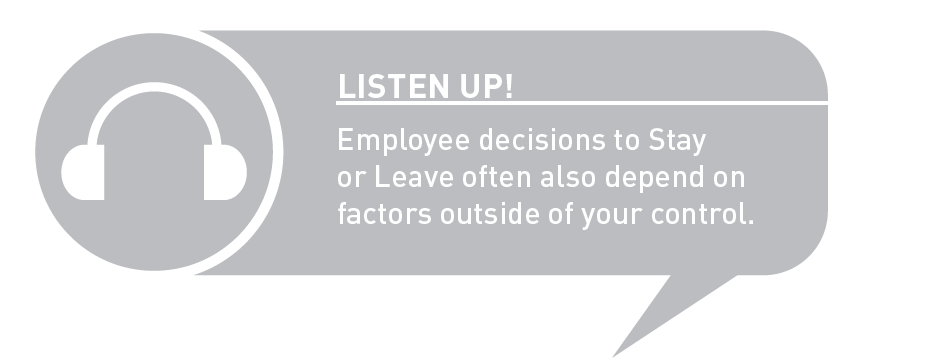
We will now share with you some examples of behaviors that you may notice among your employees who are in this turning point of the Engagement “I” Path. At the end of the list, we would like you to identify who is displaying these behaviors as you continue your plans to increase employee engagement.
Employee Behaviors
These are some employee behaviors that you may observe during the time when an employee is making a decision to Stay or Leave.
- Does not seek additional opportunities or responsibilities.
- Finds reasons to justify not participating in projects or activities.
- Responds defensively to feedback.
- Does not show interest in delivering high-quality work.
- Does not detect errors that she would have noticed in the past.
- Avoids sharing meals and breaks from work with peers, managers, and leaders.
- Maintains brief conversations on very neutral topics.
- Shows discomfort during long meetings through verbal and nonverbal communication.
- Only interacts with other team members for task-related purposes.
- Only displays company logo and other symbols when it is absolutely required.
- Does not participate in any after-hours work-related activities, without any explanation.
- Avoids interacting with leaders with whom the employee previously had developed a positive relationship.
- Is skeptical about the information that he receives about the company.
- Takes extensive notes during individual meetings with manager.
- Does not present arguments during performance reviews even if he disagrees with the results.

Now it’s your turn.
Select which behaviors from this list you have noticed among the employees who are in the Stay or Leave turning point in Worksheet 6.2.
Worksheet 6.2 Behaviors Observed From Employees in the Stay or Leave Turning Point
|
BEHAVIORS |
EMPLOYEE NAMES |
||
|
Does not seek additional opportunities or responsibilities. |
|||
|
Finds reasons to justify not participating in projects or activities. |
|||
|
Responds defensively to feedback. |
|||
|
Does not show interest in delivering high-quality work. |
|||
|
Does not detect errors that she would have noticed in the past. |
|||
|
Avoids sharing meals and breaks from work with peers, managers, and leaders. |
|||
|
Maintains brief conversations on very neutral topics. |
|||
|
Shows discomfort during long meetings through verbal and nonverbal communication. |
|||
|
Only interacts with other team members for task-related purposes. |
|||
|
Only displays company logo and other symbols when it is absolutely required. |
|||
|
Does not participate in any after-hours work-related activities, without any explanation. |
|||
|
Avoids interacting with leaders with whom the employee previously had developed a positive relationship. |
|||
|
Is skeptical about the information that he receives about the company. |
|||
|
Takes extensive notes during individual meetings with manager. |
|||
|
Does not present arguments during performance reviews even if he disagrees with the results. |
|||
Manager Dos and Don’ts
Here are some examples of what you should and should not do when an employee is in the Stay or Leave turning point.
Dos
- Provide short-term project assignments and responsibilities.
- Explain the benefits of participating in projects or activities reinforcing the employee’s potential contribution.
- Be very aware while providing feedback to avoid emotional triggers for defensiveness.
- Assign tasks that match the competencies of the employee.
- Emphasize the importance of quality in completing tasks without being condescending.
- Ensure that time allotted to complete tasks is realistic.
- Organize activities for the team where all members can share a meal or a break.
- Allow employees flexibility in choosing how to participate in projects.
- Encourage collaboration and support between employees.
- Continue to display company logo and other symbols as customary.
- Emphasize the importance of after-hours work-related activities as part of organizational identity.
- Encourage open discussions about information shared in official forums.
- Demonstrate engagement.
- Clearly define goals, objectives, and expectations.
- Ensure understanding of instructions and deadlines.
- Take notes about key points discussed during individual meetings with the employee.
- Share positive feedback received about the employee as appropriate.
- Show respect and sensitivity when handling delicate performance issues.
Don’ts
- Assume that the employee is ready, willing, and able to complete a project as she has done in the past.
- Expect the employee to be interested in participating in projects and activities that would entail additional work for him.
- Overlook current preferences or other life circumstances that may create discomfort in discussions about projects or activities.
- Disregard the potential emotional impact of feedback on the employee.
- Assign tasks for which the employee does not have the necessary capabilities and competencies.
- Make cynical references to the employee’s previous track record when explaining assignments.
- Expect high levels of energy and enthusiasm.
- Force the employee to participate in “gimmicky” team activities in which he feels uncomfortable.
- Overload other team members when an employee’s productivity is limited.
- Encourage comments and speculation about the employee’s behavior.
- Apply a double-standard for performance among employees.
- Set up goals and objectives that you do not expect the employee to meet.
- Dwell only on negative aspects of performance.
- Raise personal issues of the employee during meetings.
- Comment on your own feelings about the employee and her work or behavior during individual meetings with her or with others.

Now it’s your turn.
Worksheet 6.3 presents a behavior self-assessment for you to identify those behaviors that you have displayed or that you display typically when an employee is in the Stay or Leave turning point. Place a check mark on the right column to indicate if you display those behaviors, you do not display them, or you display them sometimes.
Worksheet 6.3 Manager Behavior Self-Assessment: Stay or Leave Turning Point
|
BEHAVIOR |
YES |
NO |
SOMETIMES |
|
DOS: |
|||
|
Provide short-term project assignments and responsibilities. |
|||
|
Explain the benefits of participating in projects or activities reinforcing the employee’s potential contribution. |
|||
|
Be very aware while providing feedback to avoid emotional triggers for defensiveness. |
|||
|
Assign tasks that match the competencies of the employee. |
|||
|
Emphasize the importance of quality in completing tasks without being condescending. |
|||
|
Ensure that time allotted to complete tasks is realistic. |
|||
|
Organize activities for the team where all members can share a meal or a break. |
|||
|
Allow employees flexibility in choosing how to participate in projects. |
|||
|
Encourage collaboration and support between employees. |
|||
|
Continue to display company logo and other symbols as customary. |
|||
|
Emphasize the importance of after-hours work-related activities as part of organizational identity. |
|||
|
Encourage open discussions about information shared in official forums. |
|||
|
Demonstrate engagement. |
|||
|
Clearly define goals, objectives, and expectations. |
|||
|
Ensure understanding of instructions and deadlines. |
|||
|
Take notes about key points discussed during individual meetings with the employee. |
|||
|
Share positive feedback received about the employee as appropriate. |
|||
|
Show respect and sensitivity when handling delicate performance issues. |
|||
|
DON’TS: |
|||
|
Assume that the employee is ready, willing, and able to complete a project as she has done in the past. |
|||
|
Expect the employee to be interested in participating in projects and activities that would entail additional work for him. |
|||
|
Overlook current preferences or other life circumstances that may create discomfort in discussions about projects or activities. |
|||
|
Disregard the potential emotional impact of feedback on the employee. |
|||
|
Assign tasks for which the employee does not have the necessary capabilities and competencies. |
|||
|
Make cynical references to the employee’s previous track record when explaining assignments. |
|||
|
Expect high levels of energy and enthusiasm. |
|||
|
Force the employee to participate in “gimmicky” team activities in which he feels uncomfortable. |
|||
|
Overload other team members when an employee’s productivity is limited. |
|||
|
Encourage comments and speculation about the employee’s behavior. |
|||
|
Apply a double-standard for performance among employees. |
|||
|
Set up goals and objectives that you do not expect the employee to meet. |
|||
|
Dwell only on negative aspects of performance. |
|||
|
Raise personal issues of the employee during meetings. |
|||
|
Comment on your own feelings about the employee and her work or behavior during individual meetings with her or with others. |
-
How many are dos and how many are don’ts?
-
Identify the three don’ts that you would like to turn into dos.
-
Identify the behaviors that you do sometimes and explain why you do so.
Re-engage or Disengage
Overview
The nature of the relationship with the company, management, and team of an employee who decides to stay at a workplace will be different than it was prior to considering leaving. Typically, an employee who chooses to stay has a less idealistic perception of the workplace than an employee who has never considered the option of working elsewhere. Consequently, his level of engagement will very likely not be as high as that of those other employees.
Upon making the choice to stay in the company, the employee must still make another decision that will affect the path that she will follow in the Engagement “I” Path. The decision of whether to re-engage with or disengage from the company constitutes another one of those turning points in the employee engagement process, just like the decision to Stay or Leave. You may be asking yourself if it is possible for an employee to re-engage.
In Re-engagement, the employee will need to re-establish relationships and reconnect emotionally with the company. However, this employee will be carrying additional emotional loads because, according to the Engagement “I” Path that we have discussed so far, she has undergone the impact of a Critical Incident, the effects of an engagement decline, and the consequences of a career and personal decision.
An employee who is in Disengagement has not been able to overcome any negative impact of a Critical Incident. As a result, his levels of engagement have continued to decline and, very likely, personal needs and commitments that are beyond your control (as his manager) have fueled the decision to stay in the company. However, since this employee is still a part of your team, you have to be there for him in this step so that he will begin to reconnect with the company; yet, you should acknowledge the fragility of the relationship at this point.
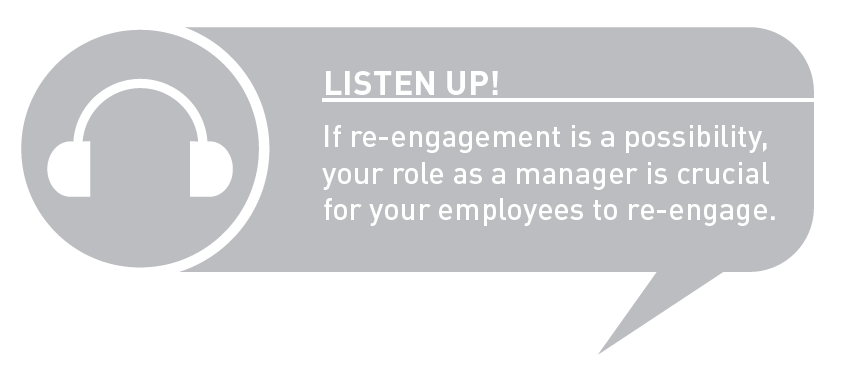
Just like the employee who joins the company and begins moving through the steps of the Engagement “I” Path, reaching the Testing the Waters step after ending the Starting Out step, the employee who chooses to re-engage or to disengage with the workplace will return to the Testing the Waters step to continue her path. Please keep in mind that the employee’s relationship with you and with the organization that you represent is very fragile at this step of the Engagement “I” Path and, like a broken glass, it will never go back to what it was before.
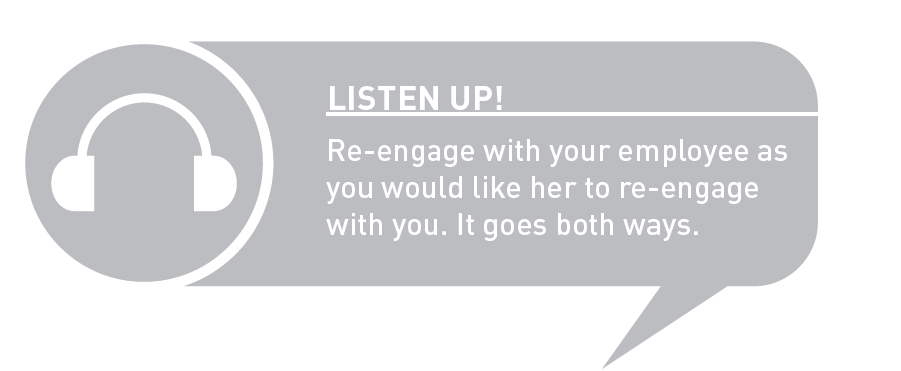
Before we continue our discussion, we would like you to continue to identify if any of your employees are in the Re-engage or Disengage turning point of the Engagement “I” Path.
Now it’s your turn.
Who is choosing to Re-engage and Disengage in this turning point? List their names in worksheets 6.4 and 6.5.
Worksheet 6.4 Employees in Re-engagement
|
RE-ENGAGEMENT |
Employee Names |
|
|
|
|
|
|
|
|
Worksheet 6.5 Employees in Disengagement
|
DISENGAGEMENT |
Employee Names |
|
|
|
|
|
|
|
|
Drivers
The primary engagement drivers that will play a role in an employee’s decision to re-engage or disengage are total rewards, performance management, intrinsic motivation, and you.
In this step, external factors play a key role. Total rewards will still be valuable in the decision to re-engage or disengage. For example, an employee may begin to exert a level of effort at work in proportion to the total rewards that he perceives to be receiving; this level of effort may be higher and lead to re-engagement, or lower and lead to disengagement.
Performance management issues related to task distribution, job autonomy, work-life balance, and performance reviews may be important for the employee at this point. He will focus mainly on task completion during regular working hours and meeting objectives to increase the likelihood of still having a position at the company. If the employee perceives a reasonable level of fairness in performance management, and overall, is satisfied with at least how some of those issues are handled, he may begin to re-engage. Otherwise, he will disengage.
An employee who is making these choices may look inward to find a sense of meaning in her work. She tries to find a reason to reconnect emotionally with the workplace or with you as a manager. If the employee cannot discover a new meaning in her work or cannot reconnect emotionally with the workplace or with you as a manager, then her path to re-engagement or disengagement will be entirely contingent on external factors such as those mentioned elsewhere in this book. That emotional connection is what will motivate the employee to work and to put forth the extra effort necessary to succeed in today’s business world.
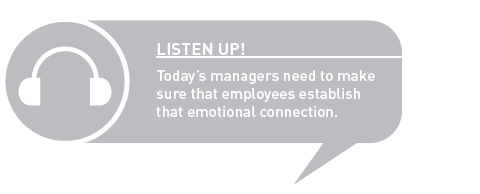
Employee Behaviors
These are some employee behaviors that you may observe when an employee is in the Re-engage or Disengage turning point.
- Seeks opportunities to participate in projects that would increase or decrease her visibility in the company.
- Adopts a “wait-and-see” attitude about any potential growth opportunities, deciding to take advantage of those that could lead to career development if re-engaging, and passing on them if disengaging.
- Completes assigned tasks beyond or below expectations.
- Quantity and quality of work improves or deteriorates.
- Carefully observes how others react to him and advances toward re-engagement if their reactions are positive, and toward disengagement if their reactions are negative.
- Self-monitors expressions and behaviors within team interactions, avoiding displays that could lead the team to confirm whether he is re-engaging or disengaging.
- Questions her own assumptions, beliefs, and values to determine whether to re-engage or disengage.
- Approaches others, particularly managers, with caution in interactions to avoid revealing information about where he is in the Engagement “I” Path.
- Controls overtly emotional responses to developmental feedback or any other criticism to avoid demonstrating whether he is re-engaging or disengaging.
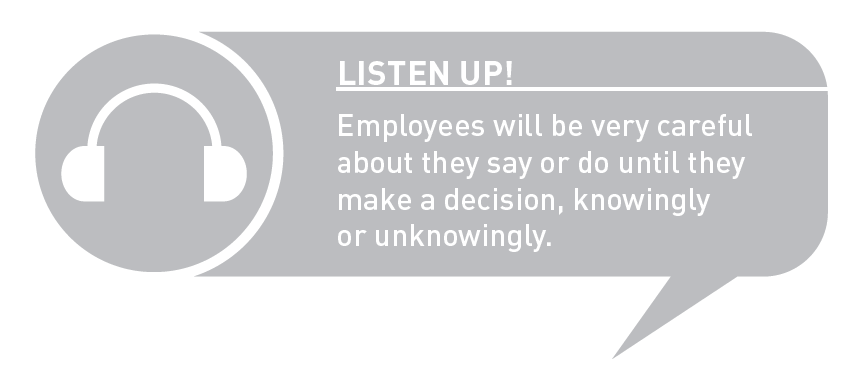
Now it’s your turn.
Select which behaviors from this list you have noticed among the employees who are in the Re-engage or Disengage turning point in Worksheet 6.6.
Worksheet 6.6 Behaviors Observed From Employees in the Re-engage or Disengage Turning Point
|
BEHAVIORS |
EMPLOYEE NAMES |
||
|
Seeks or avoids opportunities to participate in projects that would increase or decrease her visibility in the company. |
|||
|
Adopts a “wait-and-see” attitude about any potential growth opportunities, deciding to take advantage of those that could lead to career development if re-engaging, and passing on them if disengaging. |
|||
|
Completes assigned tasks beyond or below expectations. |
|||
|
Quantity and quality of work improves or deteriorates. |
|||
|
Carefully observes how others react to him, and advances toward re-engagement if their reaction are positive, and toward disengagement if their reaction are negative. |
|||
|
Self-monitors expressions and behaviors within team interactions, avoiding displays that could lead the team to confirm whether he is re-engaging or disengaging. |
|||
|
Questions her own assumptions, beliefs, and values to determine whether to re-engage or disengage. |
|||
|
Approaches others, particularly managers, with caution in interactions to avoid revealing information about where he is in the Engagement “I” Path. |
|||
|
Controls overtly emotional responses to developmental feedback or any other criticism to avoid demonstrating whether he is re-engaging or disengaging. |
|||
Let’s think about those employees who seem to be disengaging.
-
How many of your employees are disengaged because of a psychological divorce from your company, yet they are still at the workplace?
-
Are those employees productive?
-
Are they poisoning the rest of the group with their negativity?
-
What can you do to mitigate their impact on your team? List three actions.
Manager Dos and Don’ts
Here are some examples of what you should and should not do when an employee is in the Re-engage or Disengage turning point.
Dos
- Provide timely and useful positive and developmental feedback.
- Encourage questions and experimentation from employee.
- Create a safe environment to stretch talents and make mistakes.
- Pay close attention to signals and behaviors of re-engagement.
- Encourage the employee to reconnect with peers.
- Provide information as pertinent and available.
- Facilitate interactions with other managers and with members of other teams.
- Ensure the employee’s participation in company events of all types.
- Anticipate and remove barriers for the employee’s success.
- Specify and clarify roles, responsibilities, and expectations about self, the employee, the team, and others in the company.
- Reward appropriate results and reinforce appropriate behaviors.
- Respect the employee’s need for privacy.
- Acknowledge and respect the employee’s negative experiences when applicable, but encourage her to move forward.
- Be honest, but carefully.
- Avoid conflicts.
- Avoid “testing the employee.”
Don’ts
- Disregard the employee’s negative experiences and their possible impact on her.
- Show favoritism in the team.
- Overlook signals and behaviors of re-engagement.
- Provide a very general sketch about business goals without connecting them to how the employee will contribute.
- Demonstrate behaviors that are not consistent with organizational image, values, and principles.
- Assume that the employee will know what he should be doing to become reintegrated in the company.
- Leave expectations about the employee’s work undefined.
- Postpone giving positive and developmental feedback to the employee.
- Delay recognizing a job well done.
- Point out cultural mistakes that resulted from not having the appropriate information beforehand.
- Defer answering questions promptly and with not enough information.
- Criticize the employee in public.
- Provide inconsistent messages (for example, encourage experimentation, but penalize mistakes).
- Go back to “old stories.”
- Give too many assignments.
Now it’s your turn.
Worksheet 6.7 presents a behavior self-assessment for you to identify those behaviors that you have displayed or that you display typically when an employee is in the Re-engage or Disengage turning point. Place a check mark on the right column to indicate if you display those behaviors, you do not display them, or you display them sometimes.
Worksheet 6.7 Manager Behavior Self-Assessment: Re-engage or Disengage Turning Point
|
BEHAVIOR |
YES |
NO |
SOMETIMES |
|
DOS: |
|||
|
Provide timely and useful positive and developmental feedback. |
|||
|
Encourage questions and experimentation from employee. |
|||
|
Create a safe environment to stretch talents and make mistakes. |
|||
|
Pay close attention to signals and behaviors of re-engagement. |
|||
|
Encourage the employee to reconnect with peers. |
|||
|
Facilitate interactions with other managers and with members of other teams. |
|||
|
Ensure the employee’s participation in company events of all types. |
|||
|
Anticipate and remove barriers for the employee’s success. |
|||
|
Specify and clarify roles, responsibilities, and expectations about self, employee, team, and others in the company. |
|||
|
Reward appropriate results and reinforce appropriate behaviors. |
|||
|
Respect the employee’s need for privacy. |
|||
|
Acknowledge and respect the employee’s negative experiences when applicable, but encourage her to move forward. |
|||
|
Be honest, but carefully. |
|||
|
Avoid conflicts. |
|||
|
Avoid “testing the employee.” |
|||
|
DON’TS: |
|||
|
Disregard the employee’s negative experiences and their possible impact on her. |
|||
|
Show favoritism in the team. |
|||
|
Overlook signals and behaviors of re-engagement. |
|||
|
Provide a very general sketch about business goals without connecting them to how the employee will contribute. |
|||
|
Demonstrate behaviors that are not consistent with organizational image, values, and principles. |
|||
|
Assume that the employee will know what he should be doing to become reintegrated in the company. |
|||
|
Leave expectations about the employee’s work undefined. |
|||
|
Postpone giving positive and developmental feedback to the employee. |
|||
|
Delay recognizing a job well done. |
|||
|
Point out cultural mistakes that resulted from not having the appropriate information beforehand. |
|||
|
Defer answering questions promptly and with not enough information. |
|||
|
Criticize the employee in public. |
|||
|
Provide inconsistent messages (for example, encourage experimentation, but penalize mistakes). |
|||
|
Go back to “old stories.” |
|||
|
Give too many assignments. |
-
How many are dos and how many are don’ts?
-
Identify the three don’ts that you would like to turn into dos.
-
Identify the behaviors that you do sometimes and explain why you do so.
KEY POINTS AND TAKEAWAYS FROM PART II
-
Engagement is a process.
-
Employee engagement levels adjust according to an employee’s career and personal circumstances.
-
Revisit the model: Engagement “I” Path, Figure 1.
-
Be aware of the process: Starting Out, Testing the Waters, Stable, Critical Incident, Growth, Decline, Stay or Leave, Re-engage or Disengage.
-
Organizational branding and image “draw” the organizational picture for the employee.
-
Respect commitments for total rewards.
-
Take into consideration intrinsic motivation.
-
Employees are testing you as well.
-
Verify your dos and don’ts.
-
Critical Incidents are turning points.
-
Anticipate the questions. Anticipate the needs.
-
Perceptions of fairness and transparency will modify the engagement level.
-
Re-engagement cannot be imposed.
-
Communication is a key component throughout the entire Engagement “I” Path.
